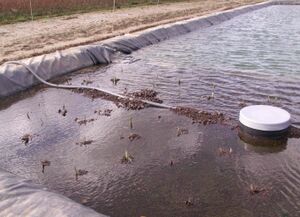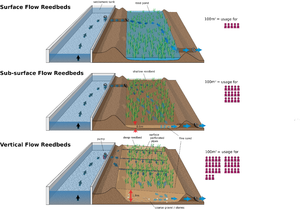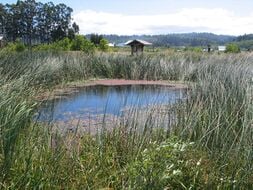
A treatment pond is a simple bioreactor for treating wastewater. It is simply a pond with bacteria and other microorganisms from the environment and the wastewater performing the treatment. The bacterial concentration is low compared to other biological treatment processes such as activated sludge, and the treatment time is also longer.
The wastewater may contain organic toxins, sediment, and/or anaerobic bacteria. The organic components of the wastewater are converted by the microorganisms (mainly bacteria), producing solids, carbon dioxide and water. Solids (including bacterial solids) settle out due to the very slow flow and the shallowness of the water.
Role of treatment ponds[edit | edit source]
Treatment ponds are used for agricultural waste, and sometimes as part of the processing of waste from food production. Industrial liquid wastes may be suitable, if there is organic content, but at a low concentration where other forms of biological treatment are inefficient.
They may also treat polluted stormwater.
Depending on the quality of the output, it may be suitable as fertilizer and irrigation water. A treatment pond may be used in combination with a rainwater reservoir to form a self-purifying irrigation reservoir or swimming pond.[1][2] Small-scale treatment can be done in small pond if the effluent is given adequate time to break down the wastewater. Smaller ponds may need to be divided in a similar way to septic tanks.
Constructed wetlands[edit | edit source]
A constructed wetland is a kind of treatment pond with an emphasis on supporting a complex ecosystem within and around the ponds.
Design[edit | edit source]
Three types of reedbed[edit | edit source]

There are three kinds of reedbed setups. They can be used in commercial systems (usually with septic tanks).[3] They are:
- Surface flow (SF) reedbeds
- Subsurface Flow (SSF) reedbeds
- Vertical Flow (VF) reedbeds
The reedbeds grow in a closed basin with a substrate medium. For most commercial purposes, ponds are lined in order to be watertight. Rubber can be used. Preventing leakage is essential in urban areas or close to residences. Substrate medium can be gravel, sand and/or lavastone.
In surface flow reedbeds a horizontal flow carries waste water between the plant roots. They are used much less in recent years, as they need a large area area, around 20 m2 per person for domestic wastewater. In cold weather smell and poorer purification are problems.[4]
In subsurface flow reedbeds, wastewater flows between plant roots below the water surface. This is more efficient, requiring 5–10 m2 per person. There is less smell and less sensitivity to cold or winter conditions. Clogging intakes are a potential problem.[4]Vertical flow reedbeds are similar to subsurface flow reedbeds, and they have similar advantages in efficiency (only 3 m2 is needed per person.[4]) and cold-weather tolerance. Wastewater flow is vertical, aided by a pump from the bottom.[verification needed] Vertical reedbeds generally use a fine sand to allow greater bacterial concentration. Oxygenation of the water is better.[verification needed] Pulsed pumping reduces obstructions in the intakes.
Organisms[edit | edit source]
Common reed (PhragmitesW) are widely used in treatment ponds (e.g., in greywater treatment systems to purify wastewater).
In self-purifying water reservoirs (for purifying rainwater prior to distribution), other plants (ie Iris pseudacorus,...)are also used. One approach is to fill the reservoirs with 1/4 lavastones and water-purifying plants.[5]
A wide variety of plants are used, and these depending on the local conditions, including climate. Indigenous plants may be preferred for environmental reasons and suitability to the local environment. Plants that supply oxygen and shade are valuable, creating an ecosystem (=submerged plants). Bacteria and suitable fish may be added to help eliminate pests. Bacteria may be grown by placing straw in water and allowing bacteria from the ambient air to grow on it. Plants are divided in four water depth-zones:
- A water depth from 0–20cm.
- A water depth from 40–60cm.
- A water depth from 60–120cm.
- Deeper water
Three non-predatory fish (surface, bottom and ground-swimmers) are chosen. This ensures the fish 'get along'. Examples for temperate climates are:
- Surface swimming fish
- Middle-swimmers
- Bottom-swimming fish
Coconut fibre.[6] can be used as a growing medium for propagating the plants.
The use of de-nutrified soil can prevent growth of algae and other unwanted organisms
Finishing[edit | edit source]
A final, shallow "polishing pond" is often used. Aeration can be carried out with cascades before passing into the final pond, or with mechanical aerators within the ponds.[7]
Combined systems[edit | edit source]
Primary treatments such as anaerobic digesters or septic tanks may be used for the initial stages of treatment where biochemical oxygen demand is sufficiently high. Grinder pumps may be used before treating a lumpy effluent, to create a slurry which is more easily processed by the bacteria.
Rooftop treatment ponds[edit | edit source]
Rooftop water purifying ponds can be built using a simple substrate, as is being done in the Dongtan eco-city.[8]
Plant-based ponds have also been designed for roofs,[9] e.g. WaterWorks UK Grow System)[10] and Waterzuiveren of Belgium[verification needed][11]
Related projects[edit | edit source]
See also[edit | edit source]
- AT settlement water distribution system
- Greywater treatment
- Constructed wetlands
Gallery[edit | edit source]
-
A simple reed bed
External links[edit | edit source]
References[edit | edit source]
- ↑ Ecologic water basins used for agriculture/irrigation
- ↑ reservoirs made self-purifying through addition of treatment pond
- ↑ reedbed descriptions
- ↑ 4.0 4.1 4.2 reedbed secriptions
- ↑ Overview of lavafilters
- ↑ Coconut growing medium used for water purifying plants
- ↑ [1] reedbed and flowform cascade polishing, Sheepdrove Organic Farm, England
- ↑ Dongtan green roofs filter water
- ↑ Description of plants used in water-purifying rooftop ponds
- ↑ WWUK rooftop water purification with plants
- ↑ Waterzuiveren.be building water-purifying roofponds

